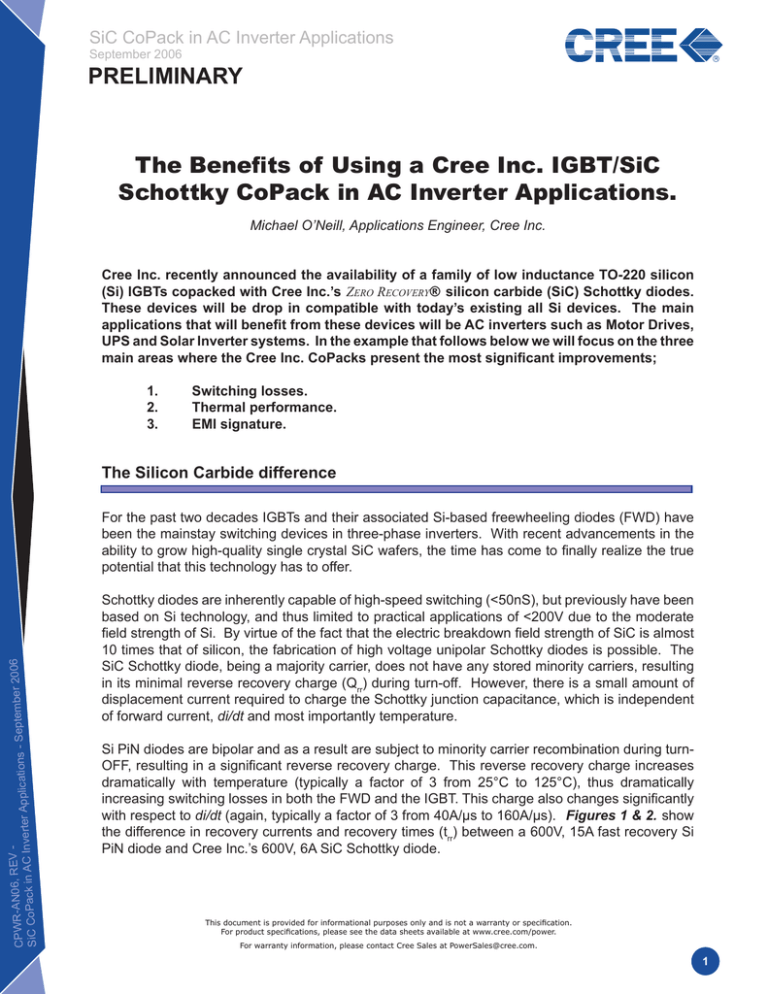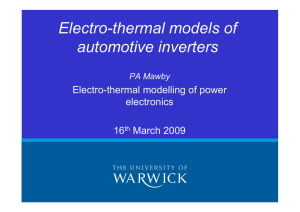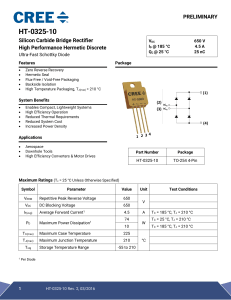
SiC CoPack in AC Inverter Applications
September 2006
PRELIMINARY
The Benefits of Using a Cree Inc. IGBT/SiC
Schottky CoPack in AC Inverter Applications.
Michael O’Neill, Applications Engineer, Cree Inc.
Cree Inc. recently announced the availability of a family of low inductance TO-220 silicon
(Si) IGBTs copacked with Cree Inc.’s ZERO RECOVERY® silicon carbide (SiC) Schottky diodes.
These devices will be drop in compatible with today’s existing all Si devices. The main
applications that will benefit from these devices will be AC inverters such as Motor Drives,
UPS and Solar Inverter systems. In the example that follows below we will focus on the three
main areas where the Cree Inc. CoPacks present the most significant improvements;
1.
2.
3.
Switching losses.
Thermal performance.
EMI signature.
The Silicon Carbide difference
VCPWR-AN06, RE
- September 2006
erter Applications
Inv
AC
in
ck
Pa
Co
SiC
For the past two decades IGBTs and their associated Si-based freewheeling diodes (FWD) have
been the mainstay switching devices in three-phase inverters. With recent advancements in the
ability to grow high-quality single crystal SiC wafers, the time has come to finally realize the true
potential that this technology has to offer.
Schottky diodes are inherently capable of high-speed switching (<50nS), but previously have been
based on Si technology, and thus limited to practical applications of <200V due to the moderate
field strength of Si. By virtue of the fact that the electric breakdown field strength of SiC is almost
10 times that of silicon, the fabrication of high voltage unipolar Schottky diodes is possible. The
SiC Schottky diode, being a majority carrier, does not have any stored minority carriers, resulting
in its minimal reverse recovery charge (Qrr) during turn-off. However, there is a small amount of
displacement current required to charge the Schottky junction capacitance, which is independent
of forward current, di/dt and most importantly temperature.
Si PiN diodes are bipolar and as a result are subject to minority carrier recombination during turnOFF, resulting in a significant reverse recovery charge. This reverse recovery charge increases
dramatically with temperature (typically a factor of 3 from 25°C to 125°C), thus dramatically
increasing switching losses in both the FWD and the IGBT. This charge also changes significantly
with respect to di/dt (again, typically a factor of 3 from 40A/μs to 160A/μs). Figures 1 & 2. show
the difference in recovery currents and recovery times (trr) between a 600V, 15A fast recovery Si
PiN diode and Cree Inc.’s 600V, 6A SiC Schottky diode.
This document is provided for informational purposes only and is not a warranty or specification.
For product specifications, please see the data sheets available at www.cree.com/power.
For warranty information, please contact Cree Sales at PowerSales@cree.com.
SiC CoPack in AC Inverter Applications
September 2006
PRELIMINARY
Vdiode 100V/div
Idiode 5A/div
Trr = 141ns
Figure 1. 15A fast recovery diode, turn-OFF (150°C)
Idiode 5A/div
Vdiode 100V/div
Trr = 29ns
Figure 2. 6A SiC Schottky diode, turn-OFF (150°C)
CPWR-AN06, REV SiC CoPack in AC Inverter Applications September 2006
This document is provided for informational purposes only and is not a warranty or a specification.
For product specifications, please see the data sheets available at www.cree.com/power. For warranty
information, please contact Cree Sales at PowerSales@cree.com.
SiC CoPack in AC Inverter Applications
September 2006
PRELIMINARY
Note that the Si device has a peak recovery current of 19A with a trr of 141ns whereas the SiC
device has a peak current of 1A with a trr of only 29ns. Also, the SiC device has no voltage
overshoot at turn-OFF. What this demonstrates is that the turn-OFF switching loss in the SiC
Schottky is about 1% of the loss inherent in the Si PiN device during worst-case conditions. When
the diode is placed in anti-parallel with an IGBT in a half-bridge circuit, the recovery currents
also add to the turn-ON loss in the IGBT. The difference in turn-ON loss in the IGBT between a
standard Si copack and the Cree Inc. CoPack with the same IGBT can be seen in Figures 3 &
4. The top two traces represent the IGBT collector-emitter voltage and collector current and the
bottom trace represents the corresponding math waveform (VCE * IC). The area under the math
waveform indicates the energy dissipated during the switching event in micro-joules.
VCE 100V/div
IC 10A/div
VCE * IC 2kW/div
Energy = 470μJ
Figure 3. Standard IGBT/Si PiN copack, turn-ON (150°C)
IC 5A/div
VCE 100V/div
VCE * IC 500W/div
Energy = 85μJ
Figure 4. Cree Inc. CoPack with same IGBT, turn-ON (150°C)
CPWR-AN06, REV SiC CoPack in AC Inverter Applications September 2006
This document is provided for informational purposes only and is not a warranty or a specification.
For product specifications, please see the data sheets available at www.cree.com/power. For warranty
information, please contact Cree Sales at PowerSales@cree.com.
SiC CoPack in AC Inverter Applications
September 2006
PRELIMINARY
Note the large overshoot in collector current at turn-ON in the all Si device that is not present in the
Cree Inc. CoPack. This is due entirely to the reverse recovery current of the Si diode in the other
copack of the half-bridge circuit, which was freewheeling load current prior to turning OFF. As can
be seen, the energy dissipated in the IGBT in the Cree Inc. copack is 85μJ in comparison to 470μJ
in the standard all Si part. This represents an 82% reduction in IGBT turn-ON energy with the Cree
Inc. device when compared to it’s equivalent all Si counterpart.
Motor Drive Example
A standard off-the-shelf motor drive utilizing standard all Si TO-220 copacks was selected for
modification. The 15A, 600V standard copacks were removed and replaced with the Cree Inc.
equivalent (CID150660). The three main areas of interest to be investigated will be overall loss
reduction, thermal improvement and impact on EMI. The drive is a 2.3kW (3HP), 240V unit that
operates at 16kHz PWM frequency. All the following readings were taken with the drive running
at rated output of 9.8Amps at 50Hz in order to realize maximum losses.
1. Loss Reduction
Because this drive is specified to meet EN61800-3 First Environment Residential for EMI approval,
the gate resistors had to be increased beyond the manufacturers recommended value in order
to slow down turn-ON in the IGBTs. The manufacturer recommends 22Ω but the drive had 39Ω
in-circuit. While this slowing down of the devices improves the EMI signature, it also contributes
to higher switching losses.
With the Cree Inc. CoPacks the EMI signature was significantly improved (as will be seen later).
In fact, the improvement was significant enough that the gate drive was modified to a steering
circuit (Figure 5.) of 10Ω RGON and 22Ω RGOFF before a similar EMI signature to the all Si unit was
achieved. This optimization yields the maximum possible Watts loss reduction while still being
able to meet the EMI standard. The difference in IGBT turn-ON waveforms observed can be seen
in Figures 6 & 7.
Figure 5. Gate-drive steering circuit
CPWR-AN06, REV SiC CoPack in AC Inverter Applications September 2006
This document is provided for informational purposes only and is not a warranty or a specification.
For product specifications, please see the data sheets available at www.cree.com/power. For warranty
information, please contact Cree Sales at PowerSales@cree.com.
SiC CoPack in AC Inverter Applications
September 2006
PRELIMINARY
VCE 100V/div
IC 5A/div
VGE 5V/div
VCE * IC 2kW/div
Energy = 747μJ
Figure 6. Standard copack IGBT turn-ON with RG = 39Ω
VCE 100V/div
IC 5A/div
VGE 5V/div
VCE * IC 2kW/div
Energy = 285μJ
Figure 7. Cree CoPack CID150660 IGBT turn-ON with RGON = 10Ω
CPWR-AN06, REV SiC CoPack in AC Inverter Applications September 2006
This document is provided for informational purposes only and is not a warranty or a specification.
For product specifications, please see the data sheets available at www.cree.com/power. For warranty
information, please contact Cree Sales at PowerSales@cree.com.
SiC CoPack in AC Inverter Applications
September 2006
PRELIMINARY
With the all Si copack the IGBT turn ON switching loss measures 747µJ whereas a measurement
of 285µJ is achieved with the Cree Inc. part. This represents a 62% reduction. The combination
of a zero reverse recovery device and the ability to turn the IGBT ON harder allows this significant
improvement.
Even though diode reverse recovery has no effect electrically on IGBT turn-OFF, there will be
a slight decrease in IGBT turn-OFF energy. Because of the significant decrease in turn-ON
switching loss the IGBTs in the system will run cooler. IGBT turn-OFF tail currents are dependent
on junction temperature thus reductions on the order of 3% to 5% in turn-OFF switching loss
can be expected at thermal stabilization. In this particular example, because the turn-OFF gate
resistance could be reduced, a 24% reduction in turn-OFF is achieved.
Figure 8. shows the Watts loss difference per copack, in the fully optimized system, between the
all Si device and the Cree Inc. part. The diagram shows the Watts losses, both switching and
conduction in the IGBT and diode for each device in the system.
Power Loss per IGBT/FWD pair (Watts)
25
20
15
12.67
10
5
0
FWD Switching loss
(Watts)
1.36
0.01
6.23
1.23
2.56
4.99
4.99
w/ Si FWD
IGBT Switching loss
(Watts)
FWD Conduction loss
(Watts)
IGBT Conduction loss
(Watts)
w/ SiC FWD
Figure 8. Watts loss comparison per device
The Cree Inc. part yields a dramatic 32% reduction in overall Watts loss in the drive’s inverter
section. The increase in conduction loss observed in the SiC Schottky is due to its smaller die
size and device physics. This increase in conduction Watts loss is negligible however considering
the significant reductions achievable in the switching losses of both the IGBT and FWD. Even with
these higher conduction losses the diode still performs well within the drive design parameters in
a full regenerative scenario by virtue of the much cooler overall system temperatures. 10µs nonrepetitive and 8.3ms repetitive surge ratings on the SiC device are listed in the datasheet and
show the device operates within all standard motor drive design guidelines.
CPWR-AN06, REV SiC CoPack in AC Inverter Applications September 2006
This document is provided for informational purposes only and is not a warranty or a specification.
For product specifications, please see the data sheets available at www.cree.com/power. For warranty
information, please contact Cree Sales at PowerSales@cree.com.
SiC CoPack in AC Inverter Applications
September 2006
PRELIMINARY
2. Thermal Improvement
These CoPacks are non-isolated devices i.e. their metal tabs are floating at collector voltage.
Because of this an isolating thermally conductive material needs to be placed between the device
and the heatsink that they mount to. Using the following equations, monitoring the pertinent
temperatures and knowing the thermal resistances it is possible to obtain a reasonable estimation
of both IGBT and FWD junction temperatures.
TJ (IGBT) = TAMBIENT + ((PIGBT + PDIODE)(Rqsa + Rqcs)) + (PIGBT * Rqijc)
TJ (DIODE) = TAMBIENT + ((PIGBT + PDIODE)(Rqsa + Rqcs)) + (PDIODE * Rqdjc)
Where,
P = Power dissipated in each device (W)
Rθsa = Heatsink to ambient thermal resistance (°C/W)
Rθcs = Case to heatsink thermal resistance (°C/W)
Rθijc = IGBT junction to case thermal resistance (°C/W)
Rθdjc = FWD junction to case thermal resistance (°C/W)
With the standard all Si device and the drive operating at full rated load in a 40°C ambient,
the model yields the following junction temperatures;
TJ(IGBT) = 112.1°C
&
TJ(DIODE) = 106.9°C
With the Cree Inc. part and the drive operating at full rated load in a 40°C ambient, the
model yields the following junction temperatures;
TJ(IGBT) = 88.5°C
&
TJ(DIODE) = 86.4°C
The Cree part yields the following reductions in junction temperatures
∆TJ(IGBT) = 23.6°C
&
∆TJ(DIODE) = 20.5°C
A thermocouple was placed in a small hole drilled in the heatsink and the thermal profiles as
shown in Figure 9. were recorded.
CPWR-AN06, REV SiC CoPack in AC Inverter Applications September 2006
This document is provided for informational purposes only and is not a warranty or a specification.
For product specifications, please see the data sheets available at www.cree.com/power. For warranty
information, please contact Cree Sales at PowerSales@cree.com.
SiC CoPack in AC Inverter Applications
September 2006
PRELIMINARY
Heatsink Thermal Profile (Si v SiC)
74.4°C
Temp. (degC)
80.0
70.0
60.0
60.5°C
50.0
40.0
30.0
20.0
0
240
480
720
960
1200
1440
Time (s)
Si
SiC
Figure 9. Heatsink temperature reduction
Note that the heatsink temperature rise from ambient (23°C) will be reduced from 51.4°C to
37.5°C or a 27% reduction.
By replacing existing all Si solutions with their SiC counterparts, the designer now has the
ability to extract more power output from the drive for the same given size packaging. In this
particular example, the drive output rating will be increased to 3.03kW (4HP). Also, with this
particular family of drives and SiC technology employed, the 0.75HP drive will become a 1HP
unit and the 1.5HP drive will be capable of a 2HP rating.
For new programs, SiC technology enables the use of reduced heat sinking and/or cooling
leading to overall system cost reduction. The Cree Inc. device also presents the possibility
of decreasing IGBT rating for the same application or allowing further headroom for higher
short-term overload capability with the same IGBT. Considering that every 10°C drop in
device temperature generally represents a doubling in MTBF, the impact of the Cree Inc.
device on reliability is dramatic.
3. EMI Improvement
Another advantage of changing to SiC Schottky diodes that needs to be highlighted is the
significant reduction in Conducted and Radiated EMI that results from the elimination of the
large “snappy” recovery currents during diode turn OFF. Figure 10. shows a comparison of
Conducted scans on one of the input phases of the drive with the limits being in accordance
with European standard EN61800-3, first environment residential, unrestricted quasi peak.
CPWR-AN06, REV SiC CoPack in AC Inverter Applications September 2006
This document is provided for informational purposes only and is not a warranty or a specification.
For product specifications, please see the data sheets available at www.cree.com/power. For warranty
information, please contact Cree Sales at PowerSales@cree.com.
SiC CoPack in AC Inverter Applications
September 2006
PRELIMINARY
Only the spectrum from 1.5MHz to 30MHz is shown, as there was virtually no difference
between technologies at the lower end of 150kHz to 1.5MHz. The yellow trace represents
the all Si “off-the-shelf” unit. The green trace represents the unit modified with the Cree
Inc. CoPack in place of the standard all Si copack with no gate drive optimization. Note the
overall reduction across the full spectrum with >5dB improvement near the peaks at 4.5MHz
and 13MHz. The blue trace represents the unit with the Cree Inc. device with the gate drive
optimized to achieve the best possible reduction in switching loss. Note the comparable
magnitude in peak levels when compared to the all Si unit.
What has been accomplished is a significant reduction in overall inverter Watts loss and a
very comparable Conducted EMI spectrum.
Yellow: All Si unit
Green: SiC w/RG = 39W
Blue: SiC w/RG = 0/22W
Figure 10. Conducted EMI comparison
Using a Lower Amperage Rated SiC Schottky.
For each amperage rating of IGBT offered, Cree Inc. also offers two different amperage rating SiC
Schottky options. The above data was generated using a set of CID150660 parts. The CID150460
can also be used in this example. The SiC Schottky in the CID150460 has a rating of 9 Amps at
TCASE = 100°C as opposed to 13 Amps at TCASE = 100°C for the CID150660. The forward voltage
drop will be higher leading to greater diode conduction losses however, the switching losses in
the diode and IGBT will still be reduced by the same amount.
CPWR-AN06, REV SiC CoPack in AC Inverter Applications September 2006
This document is provided for informational purposes only and is not a warranty or a specification.
For product specifications, please see the data sheets available at www.cree.com/power. For warranty
information, please contact Cree Sales at PowerSales@cree.com.
SiC CoPack in AC Inverter Applications
September 2006
PRELIMINARY
This part gives the designer a lower cost option with slightly less performance than the CID150660
but still presents a significant improvement over the all Si solution.
If the CID150460 devices are used in the same drive, the Watts loss reduction shown in
Figure 11. will be observed.
Power Loss per IGBT/FWD (Watts)
25
20
15
0.01
12.67
10
5
0
FWD Switching loss
(Watts)
1.36
1.23
4.99
w/ Si FWD
6.23
3.26
4.99
IGBT Switching loss
(Watts)
FWD Conduction loss
(Watts)
IGBT Conduction loss
(Watts)
w/ SiC FWD
Figure 11. Watts loss comparison per device
Note the slightly higher FWD conduction loss than with the CID150660 however, an
overall Watts loss reduction of 28% is still achieved. This part yields the following
reduction in junction temperatures;
∆TJ(IGBT) = 21.5°C & ∆TJ(DIODE) = 15.2°C
Note the IGBT junction temperature has still dropped >20°C and the increase in diode
power dissipation still yields a 15°C drop in junction temperature compared to the standard
all Si device. Even with this higher conduction loss in the diodes they still perform within
the drive design parameters in a full regenerative scenario by virtue of the much cooler
overall system temperatures. The EMI signature improvement will be exactly the same.
Also, the 10ms non-repetitive and 8.3ms repetitive surge ratings on the SiC device are
listed in the datasheet and show the device operates within all standard motor drive
design guidelines.
Figure 12. shows the difference in overall inverter Watts loss reduction between
the CID150660 and the CID150460 in this particular drive example at various PWM
frequencies. Note that the higher the PWM frequency the greater the benefit of SiC
technology.
10
CPWR-AN06, REV SiC CoPack in AC Inverter Applications September 2006
This document is provided for informational purposes only and is not a warranty or a specification.
For product specifications, please see the data sheets available at www.cree.com/power. For warranty
information, please contact Cree Sales at PowerSales@cree.com.
SiC CoPack in AC Inverter Applications
September 2006
PRELIMINARY
Watts Loss
Reduction (%)
Overall Inverter Watts Loss Reduction v PWM
40
30
20
10
0
8
12
16
20
24
Freq (kHz)
CID150460
CID150660
Figure 12. Performance differential with the lower amperage SiC Schottky.
Summary
SiC Schottky diodes in the freewheeling section of an inverter allow for efficiency, thermal and EMI
improvements that are simply not possible with current Si based technology. Smaller amperage
rated SiC diodes in the system are possible by virtue of the elimination of reverse recovery currents.
These devices also enable the possibility of running an inverter at much higher PWM frequencies.
In the example above with the CID150660 parts, it is possible to increase the PWM frequency
to 34kHz (more than double the default) before realizing the equivalent inverter Watts loss with
the standard all Si parts. Cree Inc. has designed in two different SiC Schottky amperage rated
devices for each IGBT amperage rating offered, thus giving the designer the ability to select parts
with cost/performance optimization in mind.
Utilizing Cree Inc. CoPacks presents many different improvement options to the overall system
design. Whether it is increasing PWM frequencies to reduce magnetic and filtering component
size and count, increasing power output capability to create higher output ratings from existing
frame sizes, increasing system efficiency, improving reliability or any combination of the above,
the possibilities are indeed compelling.
Copyright © 2006 Cree, Inc. All rights reserved. The information in this document is subject to change without notice. Cree, the Cree logo, and Zero
Recovery are registered trademarks of Cree, Inc.
This document is provided for informational purposes only and is not a warranty or a specification. This product is currently
available for evaluation and testing purposes only, and is provided “as is” without warranty. For preliminary, non-binding product
specifications, please see the preliminary data sheet available at www.cree.com/power.
11
11
CPWR-AN06, REV SiC CoPack in AC Inverter Applications September 2006
Cree, Inc.
4600 Silicon Drive
Durham, NC 27703
USA Tel: +1.919.313.5300
Fax: +1.919.313.5451
www.cree.com/power




